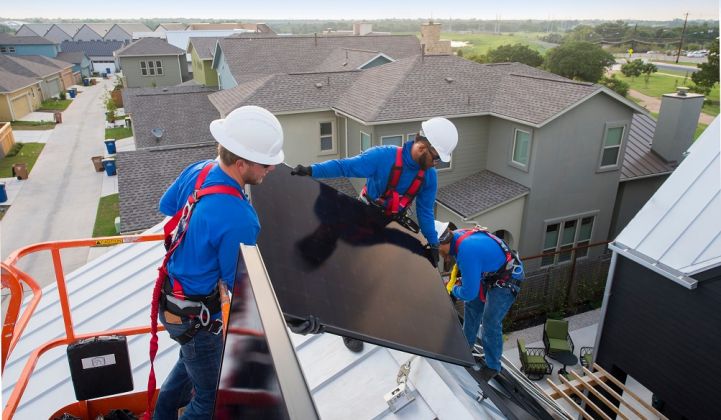San Francisco-based solar software startup Aurora Solar just got a vote of confidence from big tech.
A recently finalized partnership will incorporate Google datasets, including Light Detection and HD Imagery, into the solar modeling Aurora uses for its design software.
Aurora said the new data will help the company’s solar installer customers more accurately assess residential solar potential using 3D modeling, reducing the number of truck rolls needed to design a system. That could help cut soft costs associated with siting solar systems.
“What this partnership means is, ultimately, better data in the hands of solar professionals,” said Aurora co-founder Sam Adeyemo. “It’s going to enable you to more accurately quote the performance of a system and what a system design would look like without having to travel to the site.”
Aurora’s platform is used across the industry by companies such as Vivint Solar. In June, Aurora software helped design 80,000 solar systems, and Adeyemo said 2 million projects have now been designed using the company’s system.
The new data, in addition to that already used by Aurora, covers international locations in Western Europe and over 90 percent of the U.S. population, Adeyemo said.
Soft costs — expenditures associated with permitting, financing, installing and customer acquisition — account for upward of 60 percent of solar system costs in the U.S. The new data partnership takes aim at cutting those costs at the beginning of the process, when a roof is assessed for solar potential and shading.
However, industry analysts say that while the partnership could help cut certain costs, other, costlier parts of the process remain a pernicious barrier for drawing down solar costs further.
Ben Gallagher, a senior solar analyst at Wood Mackenzie Power & Renewables, said the Google-Aurora partnership could cut costs “around the margins of the margins” of solar design, but ultimately, “it’s not going to be a cure-all for reducing soft costs.”
That’s because moving a solar system from the sale to the installation requires numerous steps, such as ensuring structural integrity of a roof, obtaining final engineering specs and completing utility interconnection.
“What this will be able to do is better help with the lead qualification process to make sure you have the most accurate and reliable data possible,” said Gallagher. “It doesn’t solve all those other problems or all those other steps for the sales through installation process.”
Google's Project Sunroof
Google said the partnership will help it reach its solar goals.
Google started Project Sunroof in 2015 with the hope that providing access to high-quality data would accelerate solar deployment. The program first focused on reaching consumers and then policymakers to help quicken the pace of installations at a granular and then municipal level.
Now, the team is working to reach more private companies to streamline the solar business. Google already has a similar data partnership with SunPower for its Instant Design platform. European utility E.ON and Engie have also worked with Google on PV modeling.
Despite its big-time brand name, Nicole Lombardo, head of business development and partnerships at Google's Environmental Insights group, said the Project Sunroof team is relatively small within its corporate parent. She said partnerships with companies that reach many parts of the solar ecosystem, like Aurora, will help expand the benefits of Google’s data.
“Our hope is that we can continue to provide the data to as many partners...as can see some value and fit for them,” said Lombardo. “This is essentially...the beginning.”
Lombardo called Aurora’s solar design platform “a dream” that demonstrates how far the industry has come in terms of quickly designing solar systems. Incorporating Google’s data, she added, should help expand its reach to more users.
The partnership comes at a time when states and cities are spearheading climate action through renewable portfolio standards and clean energy targets.
“You can really see how we can accelerate the time not only to install but [also to] see how can we reach some of these bold, ambitious targets that a lot of cities [and states] are setting to be able to reduce their energy emissions or building emissions,” said Lombardo.
“It’s platforms like this that are going to get us there in a quicker time [frame] — and we all know it’s urgent.”




